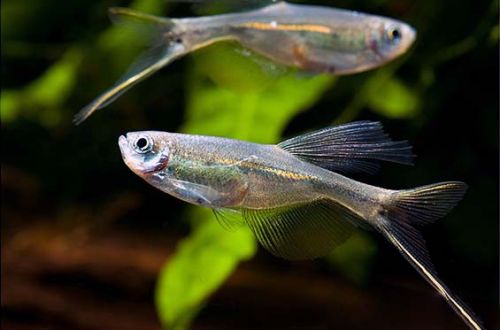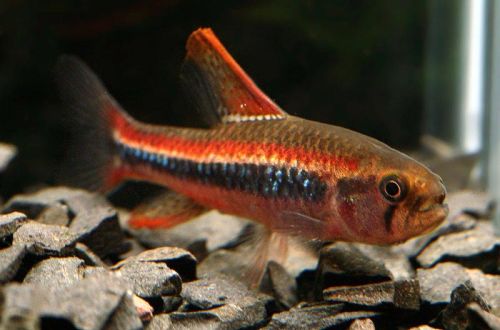
Tetra Swordsman
The Swordtail Tetra or Dragonfish, scientific name Swordtail characin (obsolete Corynopoma riisei), belongs to the Characidae family. An original fish in every respect. Although it does not differ in bright colors, its unusual appearance and the way of reproduction and behavior that are surprising for fish during the mating season make this species extremely curious for any professional aquarist.

Contents
Habitat
They originate from South America from the territory of the modern states of Colombia and Venezuela, as well as from the island of Trinidad. They live in coastal rivers and streams, but are found exclusively in clean fresh water in regions with a slow current.
Brief information:
- The volume of the aquarium – from 90 liters.
- Temperature – 22-28°C
- Value pH — 6.0–7.0
- Water hardness – soft (1-15 dGH)
- Substrate type – sandy
- Lighting – subdued
- Brackish water – no
- Water movement – absent or weak
- The size of the fish is up to 6.5 cm.
- Food – any floating on the surface
- Temperament – peaceful, timid
- Content in a group of 6 individuals
Description
Adult individuals reach a length of about 6 cm, the color of the body is silver with transparent fins. Males are characterized by the presence of two processes-filaments located one at a time on the gill covers, as well as an elongated lower beam on the tail. In the processes and on the tail are special glands that release pheromones to attract females during the mating season. In addition, there are small hooks on the fins with which the male holds the female during mating, since this species is characterized by internal fertilization.
Food
The structure of the mouth, oriented upward, indicates that the Tetra swordtail takes food from the surface. In the wild, the diet is based on small invertebrates, insects and their larvae. In a home aquarium, it will accept frozen or live foods such as bloodworms, daphnia, brine shrimp, as well as various flakes, granules and freeze-dried foods based on protein foods. They feed in the upper layers of the water, everything below or near the bottom will be ignored.
Maintenance and care, arrangement of the aquarium
For most of their life, the fish are at the surface and they don’t care much what happens below. Accordingly, in the design of the aquarium, it is necessary to provide large free spaces for swimming near the surface, and arrange the lower tier based on your wishes / capabilities and the needs of other inhabitants, if any.
It is recommended to use several floating and dense plantings of rooting plants. The substrate is sandy with numerous snags, branches or tree roots, littered with leaves. It is this biotope that is characteristic of small rivers in the rainforest canopy.
Water conditions have a slightly acidic pH value with low carbonate hardness, the temperature varies from 22 to 28°C. Water is usually painted in a slightly brown color (tea shade) due to the decomposition of organic matter, those same leaves, branches, etc. A similar effect is achieved by using peat-based filter materials in the filtration system, which also tends to acidify water.
The minimum set of equipment, in addition to the filter, includes a heater, an aerator and a lighting system. The swordtail tetra does not tolerate any, even weak currents and prefers subdued diffused light, so the equipment must be set up accordingly.
Maintenance of the aquarium comes down to a weekly replacement of part of the water with fresh water (15–20% of the volume), regular cleaning of the soil from waste products and glass from plaque. When using natural, non-decorative leaves, they are updated every 2-3 weeks.
Behavior and Compatibility
Peaceful in relation to other species, but within the group between males there are skirmishes for the attention of females. Fortunately, this rarely leads to injury, but makes the males constantly in good shape. Keeping in a flock of 6 individuals is highly recommended; if kept alone, the fish will become lethargic and drooping.
Compatible with most other species of similar size and peaceful disposition that can live in similar conditions. Usually these are other characins, catfish Corydoras or South American cichlids.
Breeding / breeding
This species is distinguished by unusual behavior during the mating season and a special way of reproduction, when the eggs are fertilized inside the body of the female, and therefore spawning can take place in the absence of males.
In various sources (special literature, websites, etc.) there is a rather contradictory description of the process of breeding Dragonfish, which, however, can be reduced to the following – the fish do not impose strict requirements and it is quite possible to get offspring at home. The stimulus for the beginning of the mating season is the inclusion of a large amount of frozen or live food in the daily diet and the establishment of water parameters at the following values: pH 6.0–7.0, dGH 1–5 at a temperature of 26–28°С. After a while, the behavior of the fish will change.
In males, the processes on the gills increase, with which they actively pull, and this attracts females so much that they even bite them. If you observe this behavior for several days, then it is almost certain that the eggs are already fertilized. Females are able to store eggs for several weeks, waiting for suitable conditions.
Spawning is preferably carried out in a separate tank in order to protect the fry from adult fish, which, on occasion, will eat them with pleasure. A spawning aquarium of about 20 liters is sufficient. It uses dense thickets of small-leaved plants located at the bottom along the entire perimeter. Lighting is subdued, a simple sponge airlift filter is used as filtration and aeration.
Females are placed in a spawning aquarium and after a while (the process can take up to a week), fry should be expected. From this moment on, the young mother is transferred back, and the juveniles become left to themselves. It is worth noting that the number of fry in Dragonfish is much less than in other characins, which is associated with a more efficient method of reproduction and, as a result, greater survival of the offspring.
Fish diseases
In a balanced aquarium ecosystem and with proper care, the likelihood of diseases is minimized. Therefore, in the event of the first signs of ill health, first check the conditions of detention and only then proceed to treatment. Read more about symptoms and treatments in the Aquarium Fish Diseases section.





